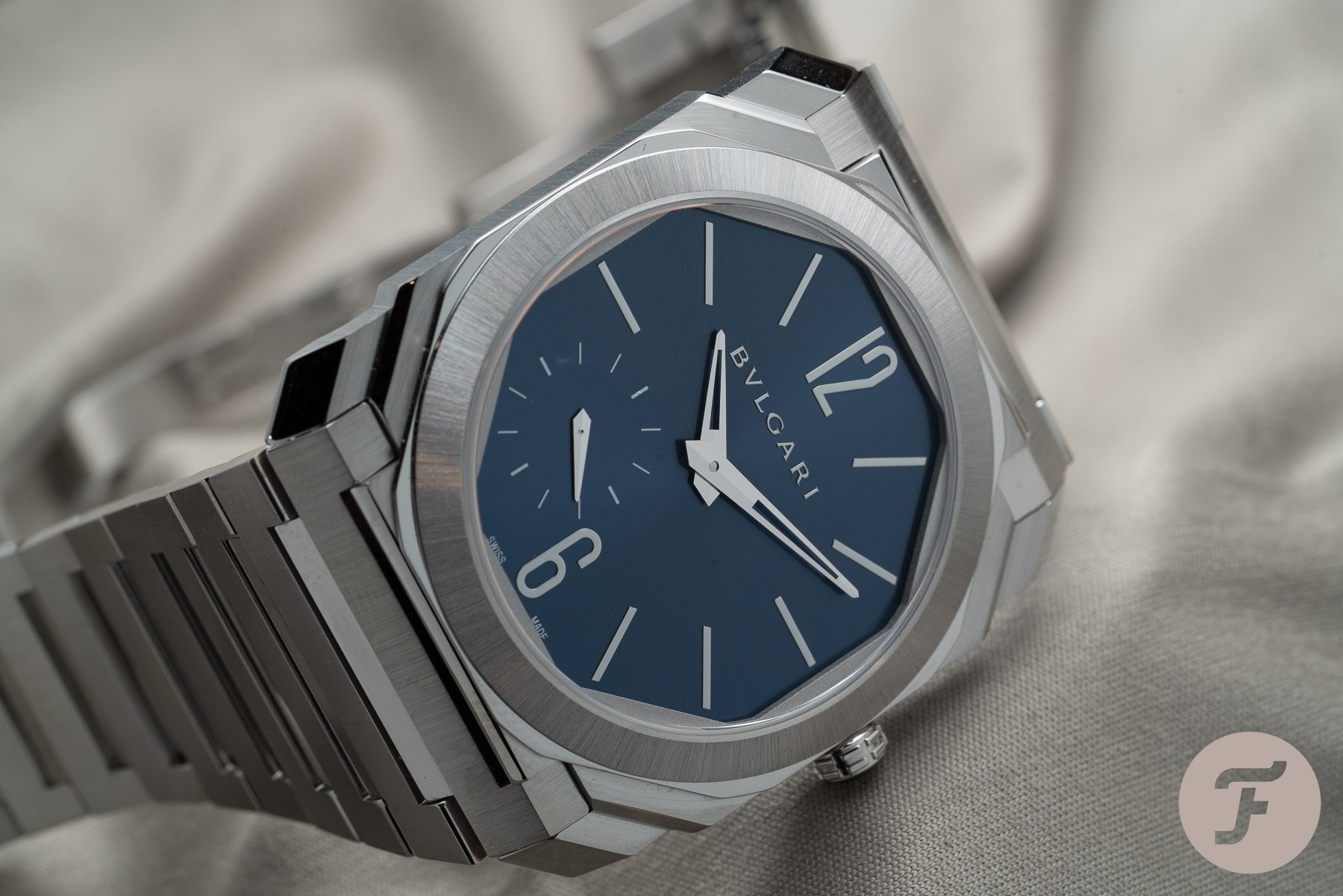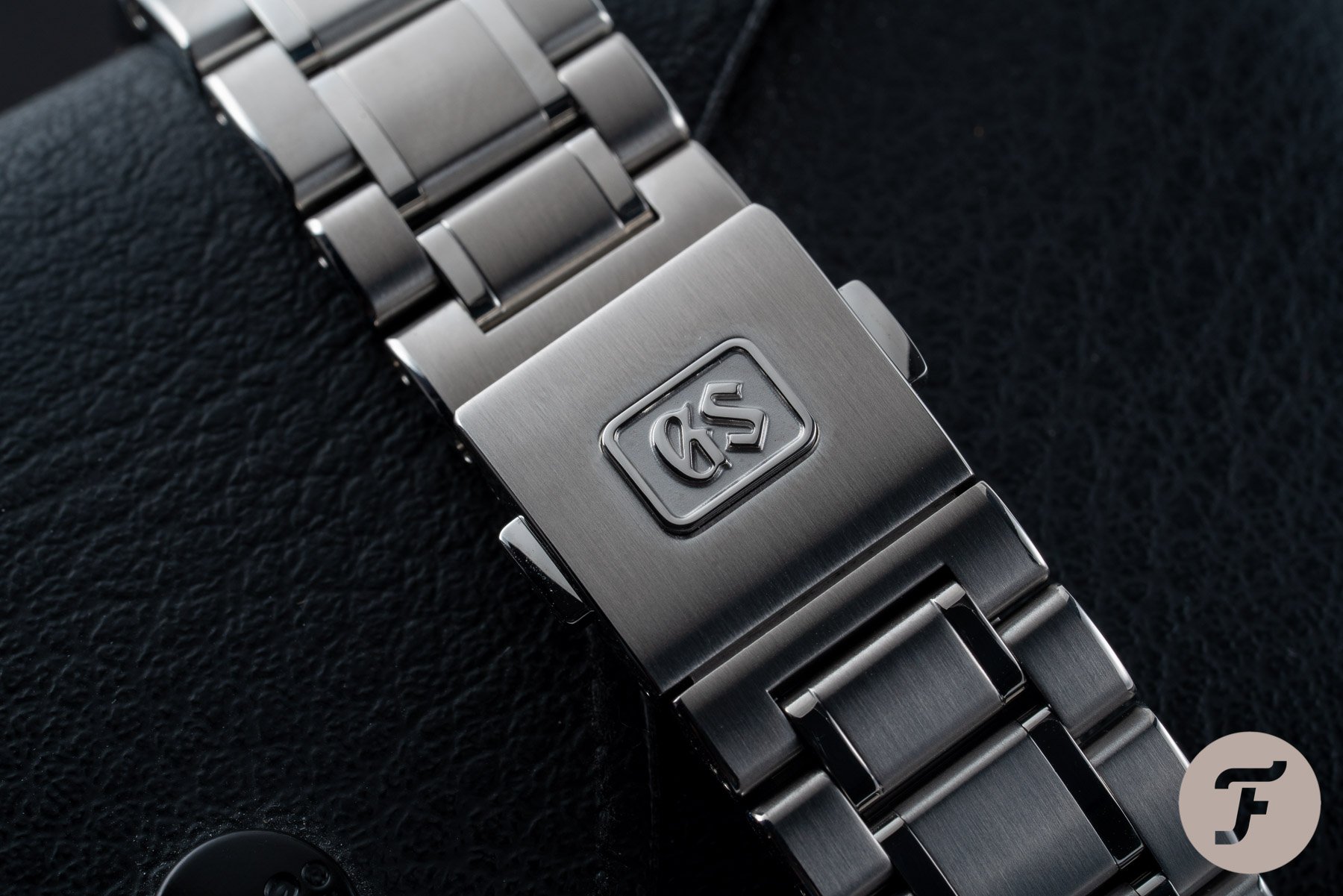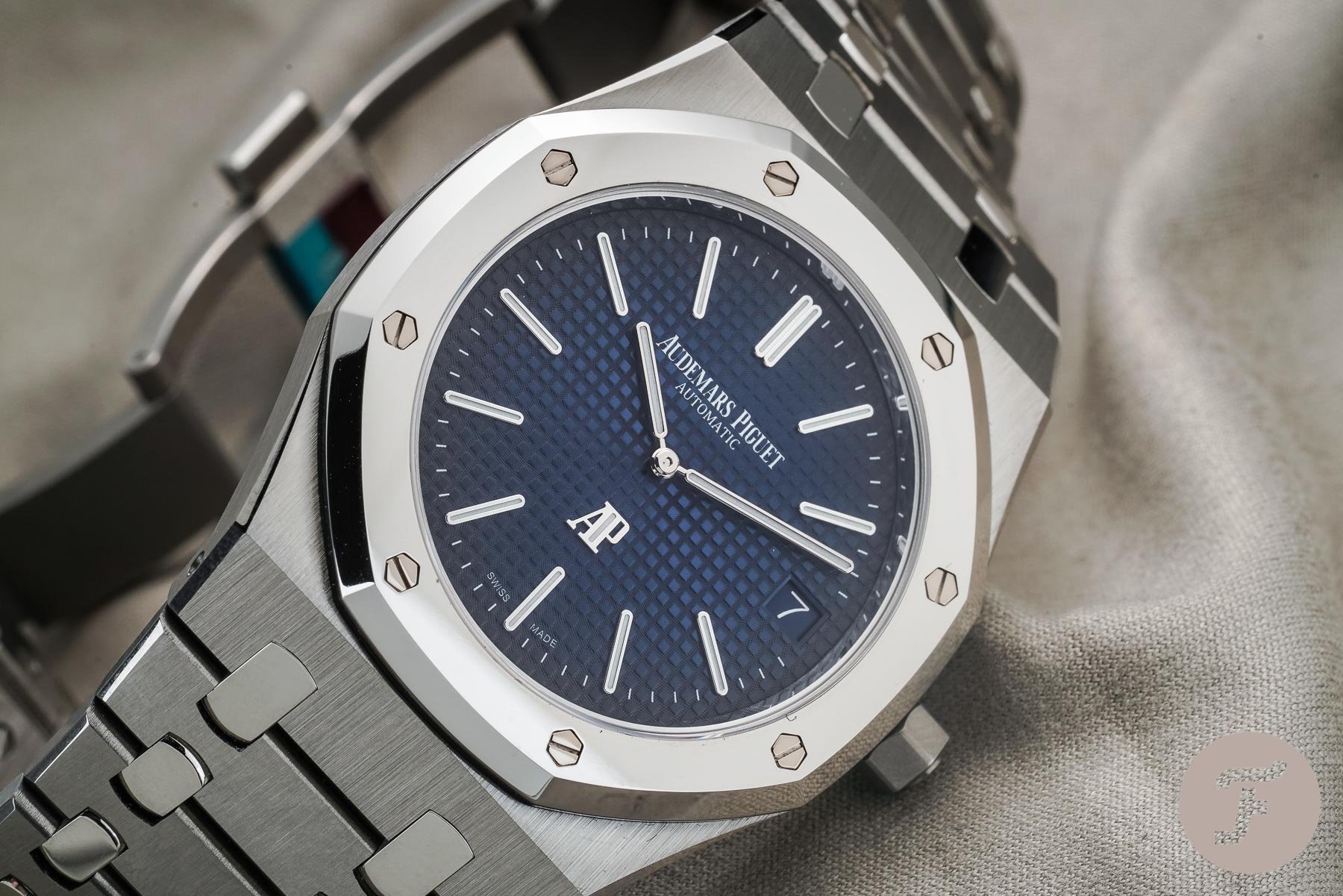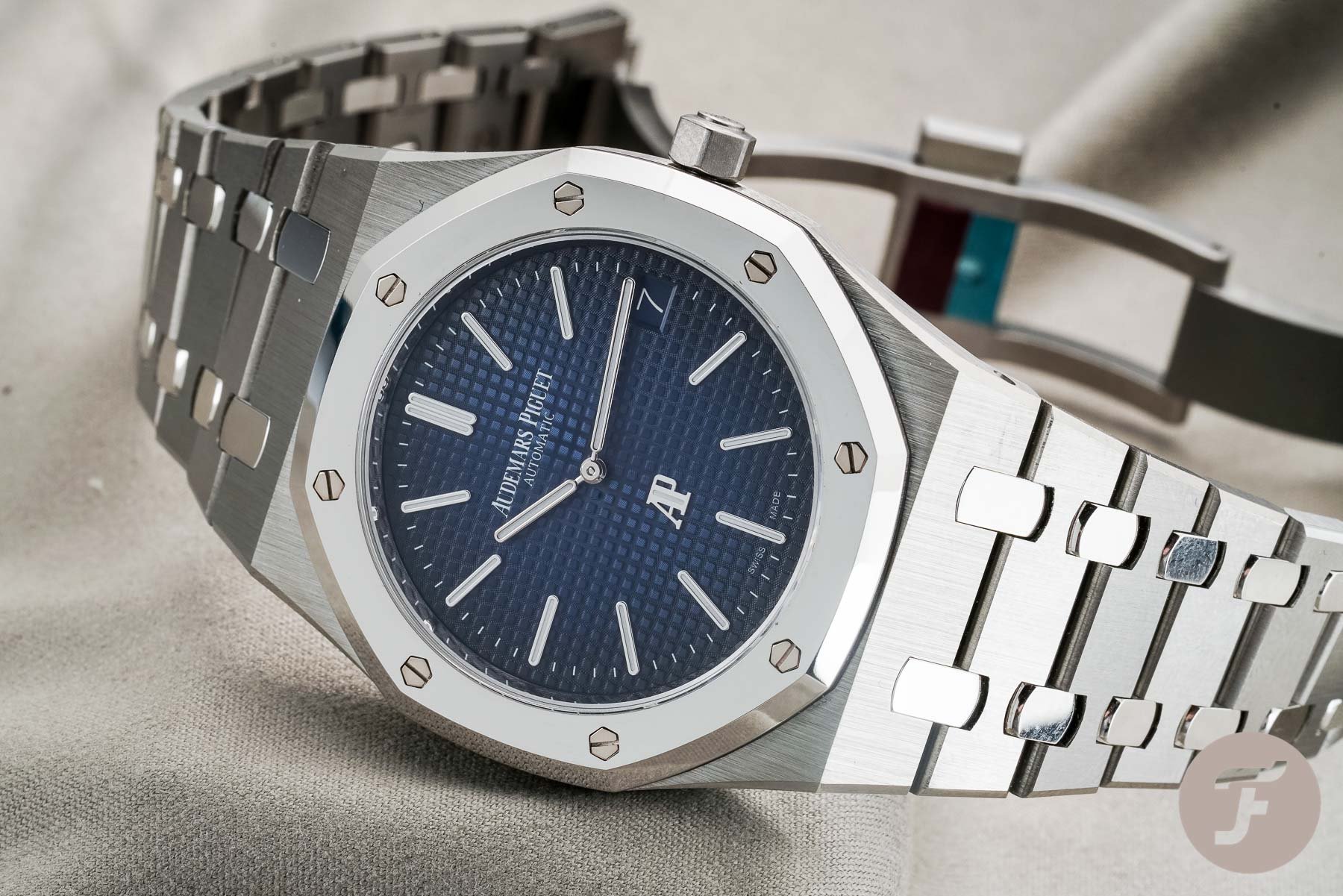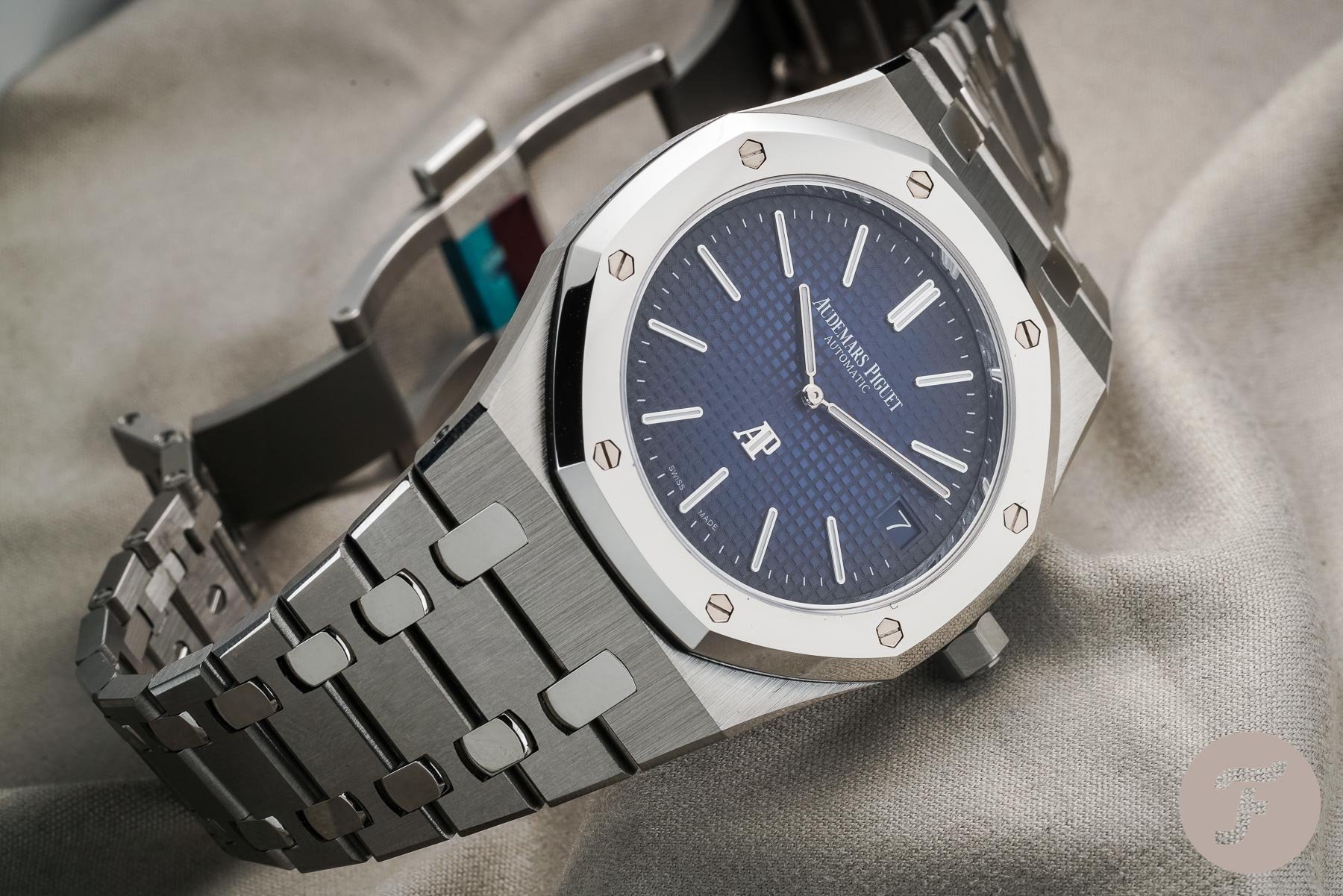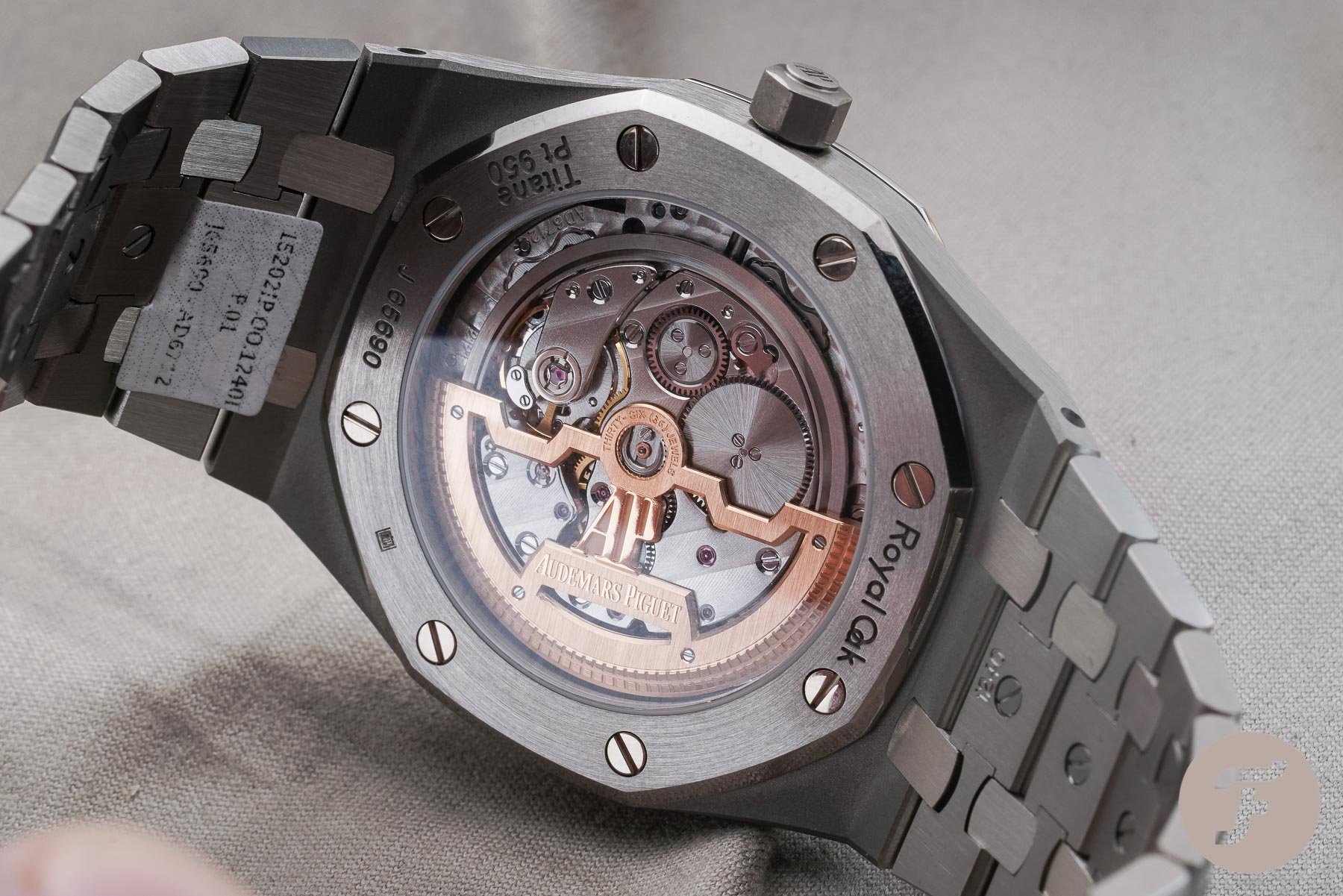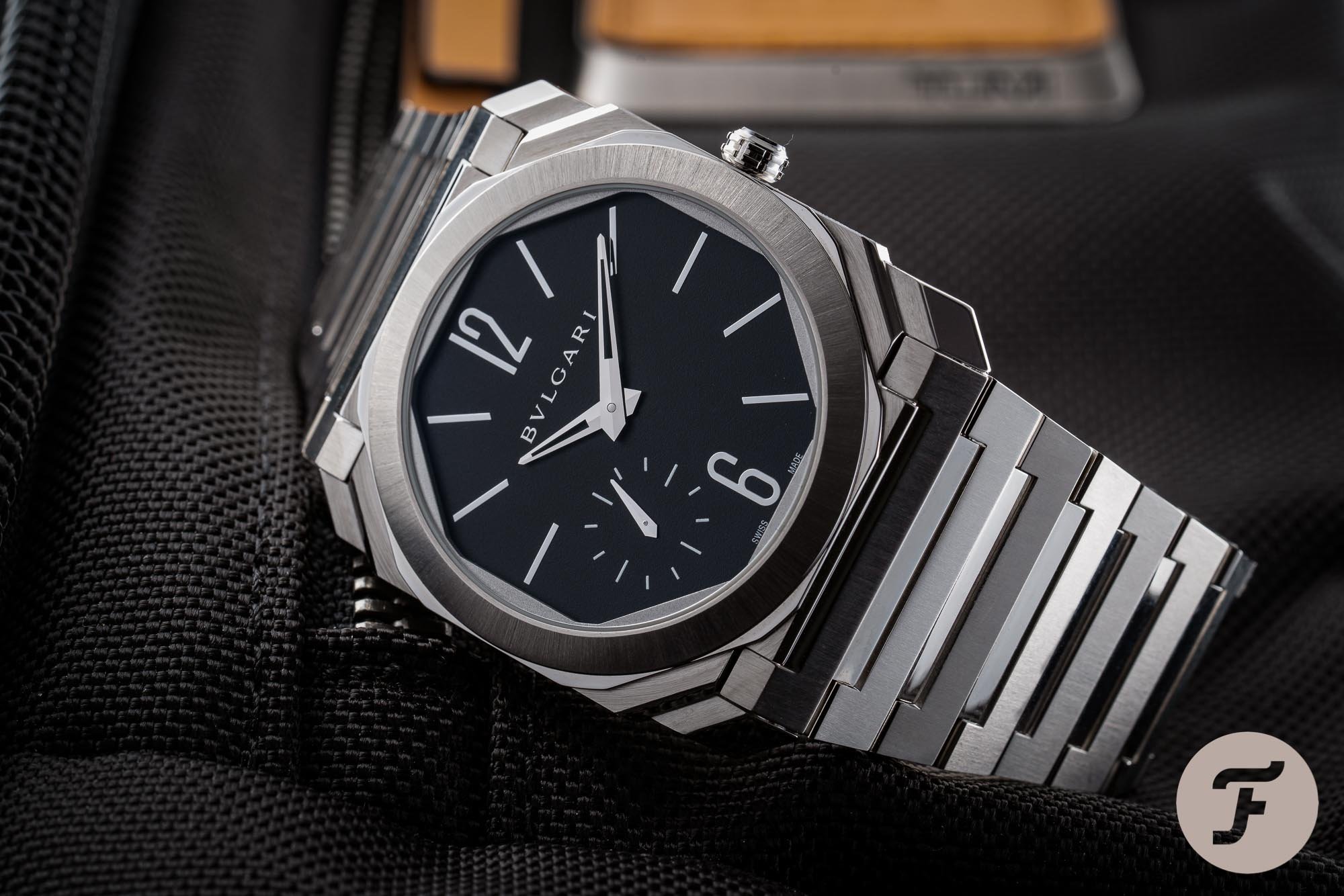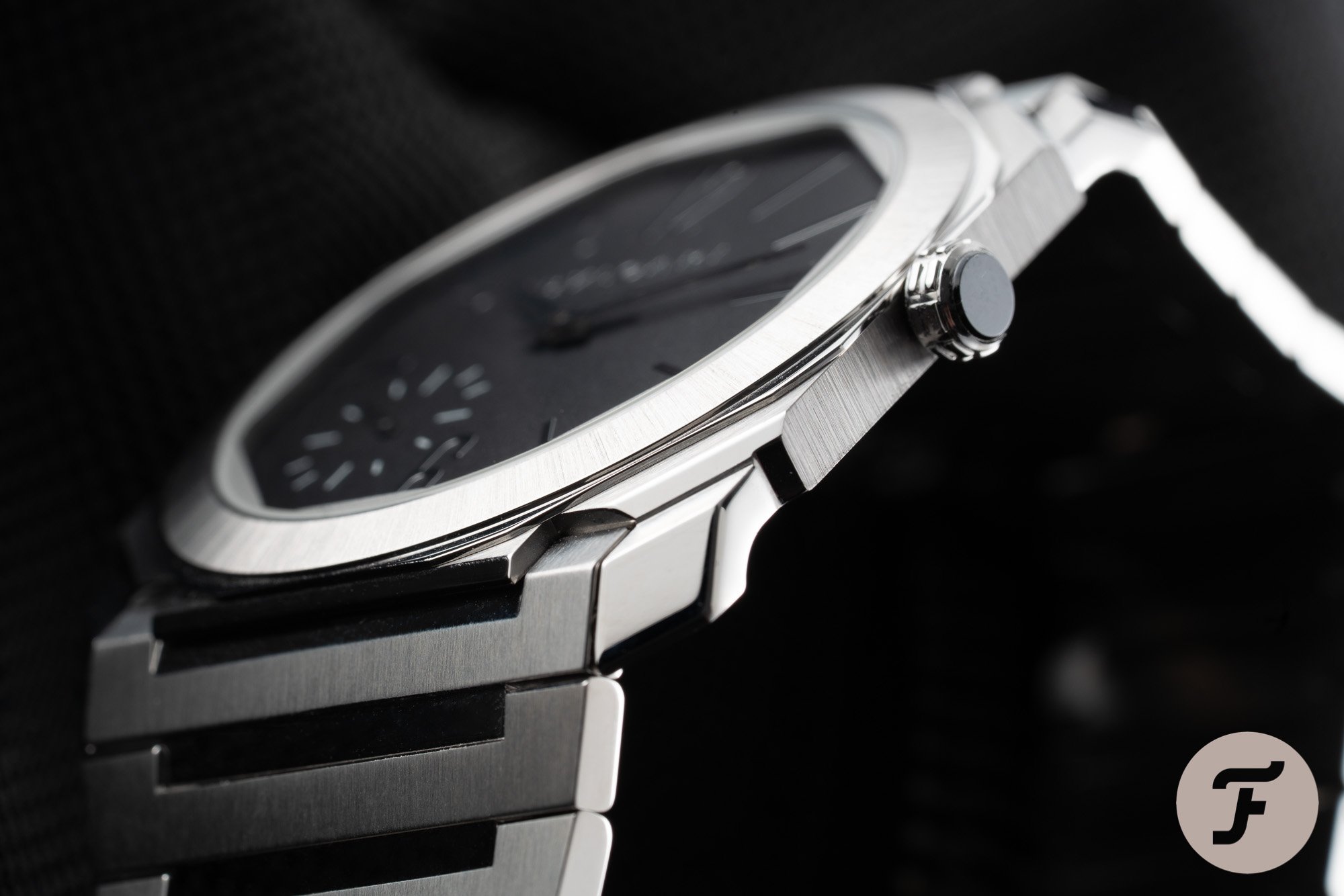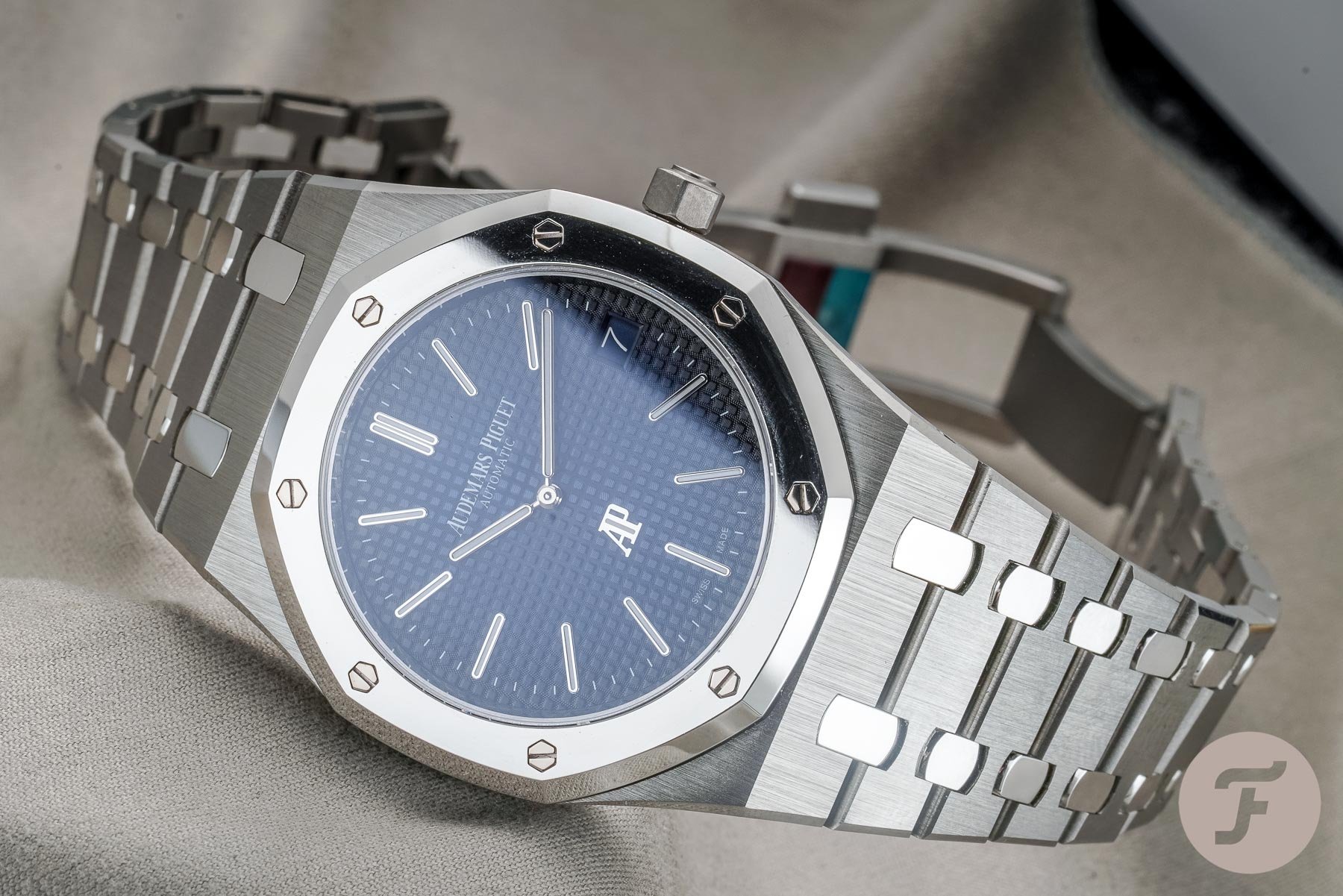Sunday Morning Showdown: Master And Apprentice — Audemars Piguet Vs. Bvlgari
In our Sunday Morning Showdown, two of our writers go head-to-head in an epic showdown for the ages. Strong opinions and hysterical hyperbole are welcome (so feel free to join in with the fun in the comments section below). And don’t forget to let us know which watches you’d like to see torn to shreds/effusively exalted next week. We’ll try and feature as many of our readers’ choices as we can. This week we line up two modern luxury steel sports watches from the mind of Gérald Genta. The Royal Oak is one of Genta’s pioneering designs, while the Octo Finissimo continued his legacy when Bvlgari acquired his eponymous brand. Which one would integrate into your life?
Like Hansel in Zoolander, modern luxury steel sports watches are “…so hot right now.” Social media is plastered with images of the Audemars Piguet Royal Oak and the Patek Philippe Nautilus — not always by the most appreciative owners. Independent brands like Czapek give their take on the concept yet appeal more to the core enthusiast community. Tissot released its quartz and automatic PRX; Citizen announced the Caliber 0200, and, honestly, the list goes on. We can see many more brands jumping on the bandwagon to come, and it’s getting a little boring.
Audemars Piguet Vs. Bvlgari
But if there is one marque that escapes the scrutiny of following trends, it’s Bvlgari. Absorbing the Gérald Genta brand’s expertise along with Daniel Roth and Bvlgari’s unique style birthed the Octo. This trifecta of concepts breathed life into the watchmaking arm of Bvlgari and gave us the most original design in decades. Later the ultra-thin caliber construction made the Octo Finissimo (very fine in Italian) a possibility. The thinner case layout somehow accentuated all the plentiful facets without appearing bulky. Now the real test for the Octo Finissimo is to face its ancestor, the Audemars Piguet Royal Oak, in a one-on-one shoot-out.
Seiko and its Grand brethren
To recap our last outing, the Seiko and Grand Seiko Spring Drive titanium dive watches faced each other with harpoons at the ready. The Grand Seiko speared the Seiko, which was not too surprising. The Grand Seiko SBGA231G had a significant margin of 61%, but not exactly a landslide against 39% for the Seiko SNR029J1. Could it be that Seiko enthusiasts are coming round to the recent price increases? Many of our readers made their appreciation for their Prospex LX models well-known. It’s got us thinking about future Sunday Morning Showdowns, for sure — so, keep an eye out for this in the coming weeks. But now, back to our regularly scheduled programming.
The Genta legacy
Today’s topic is one of master and apprentice. Undoubtedly, the Audemars Piguet Royal Oak 15202 takes the title of the master. Reference 15202 has been the cornerstone of maintaining the distinct design cues of the 1970s reference 5402 — the original Gérald Genta design that kickstarted the revolution. As for the original Royal Oak, this watch was introduced in the middle of the quartz crisis and was priced at ten times the Rolex Submariner’s cost at 3,300CHF. The most recent Royal Oak 15202 Extra-Thin was announced in 2012 to mark 40 years since its inception. This one reference, especially in steel, is one of the most sought-after and difficult to obtain models in AP’s portfolio.
Bvlgari acquired the Gérald Genta brand in 2000.
But is the Bvlgari Octo Finissimo an apprentice? Well, the Gérald Genta brand was acquired by Bvlgari in 2000. So, as a result, the Gérald Genta DNA unavoidably still flows through the sharp lines and smooth curves of the Octo. The expertise of the team that worked for the Gérald Genta brand certainly helped Bvlgari develop the concept for the Octo Finissimo and launch it to the forefront. It seems to follow the Genta mandate of a slim profile, defined angles, and an integrated bracelet. Yet the Octo Finissimo cuts a niche all on its own. But is it enough to take the Royal Oak crown? It is time now for our writers to stake their claim.
Ben — Audemars Piguet Royal Oak 15202
I’m in two minds about this week’s matchup. It’s certainly a good fight with the Octo Finissimo stepping into the ring following an extensive Rocky-style training montage to face its forefather. On the other side, I find myself defending a brand that inspires mixed feelings. Before Code 11:59, Audemars Piguet was somewhat one-note — however, that note was exceptional.
Jorg: One could argue whether the Code 11:59 did really change that but please do continue.
Ben: The Royal Oak was a stunning execution from the outset. I could go into the long-winded history of Gérald Genta and how his most famous creations came to be, but I already did that over 12 months ago. Check out my article here to read more of Genta’s approach to artistic inspiration.
I won’t dwell too much on the past, as there are distinct generations of the Royal Oak. The modern creations dedicate an extreme proportion of the effort to the finishing. Bvlgari may be stepping up its game, but AP is truly the master of applying the perfect brush strokes and alternating polished elements. Reference 5402, while being the forebear, did not have the exacting nature of finishing that you now see on all versions of reference 15202. When you have an icon in your collection that has to live up to its reputation, finishing is the aspect that truly separates the wheat from the chaff.
15202 or bust
Where it begins to fall apart at AP for me are all the models surrounding the 15202. I find any Royal Oak that strays too far from reference 5402 unappealing. The 41mm models, with the current reference 15500, somehow look like poor imitations rather than an upsize of the original. Such is the delicate proportions of the original design that any meddling leads to an imbalance.
Jorg: Preach Ben preach! I couldn’t agree with you more.
Ben: It’s a tight-rope to walk and one that AP has fallen foul of on plenty of occasions. Yet, the brand’s success in its Haute Horlogerie field is unparalleled, so it has found a winning formula.
I do commend Audemars Piguet for embracing the standout of its collection and finding new ways to reshape the Royal Oak in a myriad of configurations, whether good or bad. I could not say the same of Patek Philippe, who seem a little embarrassed of the Nautilus’ demand. Sales reps are reportedly instructed to disparage the Nautilus to steer the customer towards one of its hundreds of other references that do not have the same market. I have experienced this first hand, and it’s a little insulting to be deterred from where my interests lie to a reference of very little interest.
The greatest bracelet of all time
There, I just said it in the sub-heading. The Royal Oak’s bracelet is a masterstroke of ergonomic artistry — lightning in a bottle penned in great detail by Genta. Even the first reference implemented the design as close to the sketch as possible. That original structure has been unwavering in all iterations of the Royal Oak, including the Offshore that essentially expands the volume of material per link. Unlike the case diameter, the fit and feel of the bracelet is perfect in any dimension. It may not be infinitely adjustable with the butterfly clasp system, but it hugs the wrist like no other once sized appropriately.
The strobing effect of the bracelet is almost hypnotic.
The real show starts when rotating your wrist to reveal the time. Each angle of the links catches the light in varying reflection levels, causing a strobing effect that’s almost hypnotic. You may even forget to read the time as you’re so mesmerized. Some of you may have noticed I’m displaying the titanium×platinum version for the 15202 portions of this Showdown. This was deliberate to showcase how even in exotic materials, the Genta aesthetic shines through. The Royal Oak in steel may have been the intention of the sporty design, but for me this was merely a jumping point for its potential.
Powering prowess
Caliber 2121 is often dismissed as a derivative of the caliber 920 developed by Jaeger-LeCoultre. Well, it was Audemars Piguet that bankrolled the movement’s production. The ultra-thin movement features a bi-directional self-winding rotor with 40-hours power reserve and comes in at an insane 3.05mm. That may be more than the Bvlgari record-setters, but consider the initial designs were drawn up in 1967. It just so happened to compliment the Royal Oak’s necessity for slim and discreet comfort. JLC never fitted the base 920 movement to any of its watches, and AP subsequently took over manufacturing the caliber to control the output.
It also allowed the finishing to flourish and to be visible through the sapphire case-back. A view of the movement is a luxury for the Royal Oak. Previous generations had solid case-backs that bear the name of the model in a stylized font. With the exhibition window, the anglage polishing on the edge of the bridges can be observed. Anglage polishing has a practical use, too — it’s a bit like singeing the frayed ends of a cut rope with a lighter to seal the material and add rigidity. The many iterations of the Royal Oak fluctuate in pricing, but for an apples-to-apples comparison with the Octo Finissimo, the stainless steel reference 15202 is €25,000. It’s a price that’s hard to defend, but the iconic status has its fans clambering to be given the privilege of buying it at this price.
Jorg — Bvlgari Octo Finissimo
Let me start by saying that I love both the Audemars Piguet Royal Oak and the Bvlgari Octo Finissimo. Despite the Royal Oak’s design turning 50-years old next year, it still feels fresh and unique. No doubt next year will bring a slew of anniversary Royal Oaks. Let’s hope AP handles it better than Patek did for its 40th anniversary of the Nautilus. But no matter how much I appreciate the design and the iconic status of the Royal Oak, Bvlgari’s new kid on the block sparked a genuine excitement I had never experienced in recent memory. I felt this as soon as I first saw the sandblasted titanium Octo Finissimo on a bracelet in 2017. While it isn’t nearly as revolutionary as the Royal Oak was in 1972, seeing Bvlgari nailing a concept in the same spirit as the Royal Oak was thrilling.
The integrated bracelet was the final piece of the puzzle.
The Octo collection had been around since 2012, but it always felt a bit underwhelming. Bvlgari’s watch designer Fabrizio Buonamassa Stigliani added the final piece of the puzzle by designing the marvelous integrated bracelet. It completed the seamless and singular architecture of the Octo, especially showcased within the Finissimo. This closely follows the ethos Gérald Genta set out as a way to re-energize the stagnant watch industry of the ’70s. But that’s not where it ends. Bvlgari chose to execute every single one of the Octo Finissimo releases in a beautiful monochromatic way. The combination of materials and finishing gives the Octo Finissimo line its own unique characteristics.
The Bvlgari Octo Finissimo materials
From the initial titanium version to the rose gold version and the black ceramic version, they all showed how the Octo Finissimo concept works brilliantly in different executions. But in order for the Octo Finissimo line to connect to a larger audience, the stainless steel version was always going to be the true proof of concept. And the stainless steel version that was always teased finally came to fruition in 2020. Presented in Dubai in early 2020, the stainless steel version stepped away from the monochromatic execution from previous releases.
The first stainless steel version was presented with a black dial creating an aesthetic that is a bit more lively and caters to people that might not have been sold on the initial case materials. For the steel version, Bvlgari elected to use satin polishing rather than sandblasting for the case and bracelet. A brilliant choice because by doing so, it does keep all the same look and feel of the titanium and ceramic versions. A couple of months after the introduction of the first steel version, we saw the release of a steel version with a blue dial. And just recently Bvlgari added the new Octo Finissimo S with a steel dial that restores the initial concept of steel in full glory. Every single one of the stainless steel releases shows the strength of the Octo Finissimo design.
The execution of the concept
Let’s zoom in a bit closer to find out what elements make the Octo Finissimo a potential future classic. The 40mm case combines various shapes and angles that stack together and optically bring the dial into focus. It has the magic of feeling different yet familiar at the same time. Despite the complex arrangement, the case is ultra-thin at 6.4mm. Fellow Fratello team member Gerard and I discussed the slim profile at length. The ultra-thin feature is something that is regularly forgotten when we see copycats of the Genta-mantra popping up here, there, and everywhere. But it was a crucial part of Genta’s vision and became a mainstay of the Royal Oak, the Nautilus, and the Ingenieur.
A record-breaking 2.23mm thin automatic movement.
With the DNA residing with the Italian fashion house, Bvlgari took ultra-thin watchmaking to the next level. The Bvlgari team developed the record-breaking 2.23mm thin automatic BVL 138 movement with the help of a platinum micro-rotor. When fully wound, it provides 60-hours of power reserve. On top of that, it receives a high-grade finish with a Côtes de Genève decoration, chamfered bridges, and a mainplate with a circular grain finish. It makes it a joy to observe through the display case-back. If you turn the watch around, you are greeted by the characteristic dial layout with off-centered subsidiary seconds. The typeface is instantly recognizable as Bvlgari and the dial provides all the necessary information with little embellishment.
Ben: Perhaps a little texture wouldn’t go amiss. The dials of the Octo only showcase the vast expanse of space.
It’s all about the finish
Next up is the amazingly designed and very comfortable integrated bracelet. As Buonmassa Stigliani explained to Robert-Jan last year, creating a bracelet is often an underrated aspect of designing a watch. He realized that getting it wrong could tank the model line. And therefore he gave care and attention to the bracelet design. I am glad that Bvlgari took its time to get it right. Not only does it look spectacular with its brilliant mix of satin and high-gloss polishing, but it also emphasizes the character of the case head. Additionally, its refined design makes the watch an absolute joy to wear.
The future icon of this generation.
It may not have been executed immediately, but all the ingredients were there at Bvlgari to nail the Octo Finissimo design. Coming along for the ride and witnessing Bvlgari nailing the concept with each announcement has been a joy for every release. With a list price of €12,300, the Octo Finissimo is also roughly half the Royal Oak price. I may still lust after the Royal Oak, but the Octo Finissimo feels more in reach without compromising Genta’s core values. I think it was our own Rob Nudds that perfectly explained the impact of the Octo Finissimo. While the Royal Oak is without a doubt a classic and deserves all its praise — with all the social media hype you could argue whether it’s not too much — the Octo Finissimo has the potential to be the future icon of this generation.
Final thoughts
Jorg: As I mentioned earlier Ben, I love both of these watches a lot. So in all fairness, owning them both would be the ideal situation. But as it is customary in our Sunday Morning Showdown, it’s about making choices. And as it is right now, my choice is an easy one. The Octo Finissimo offers everything that makes the Royal Oak such a great icon. And it does so with an ownable and unique design and without copying the looks of the Royal Oak. Something that other brands have a little more trouble with when cooking up a luxury steel sports watch. And it does so at a list price that makes it even more attractive.
Ben: The Royal Oak outstretches its retail price anyway, so I’ve lost the battle on that one. But the Royal Oak is so much more wearable and feels more robust and sporty. The Octo Finissimo comes away feeling dainty and delicate without the credentials that make it suitable for the great outdoors. The blocky shape also makes it a hit or miss for most wrists. AP’s Royal Oak has that extra step of adaptability with the iconic status to boot.
But enough from our side, let’s hear from our readers which of these two watches takes the win. Is it going to be the master or will it be the apprentice? Vote for your favorite and let us know in the comment section below.

